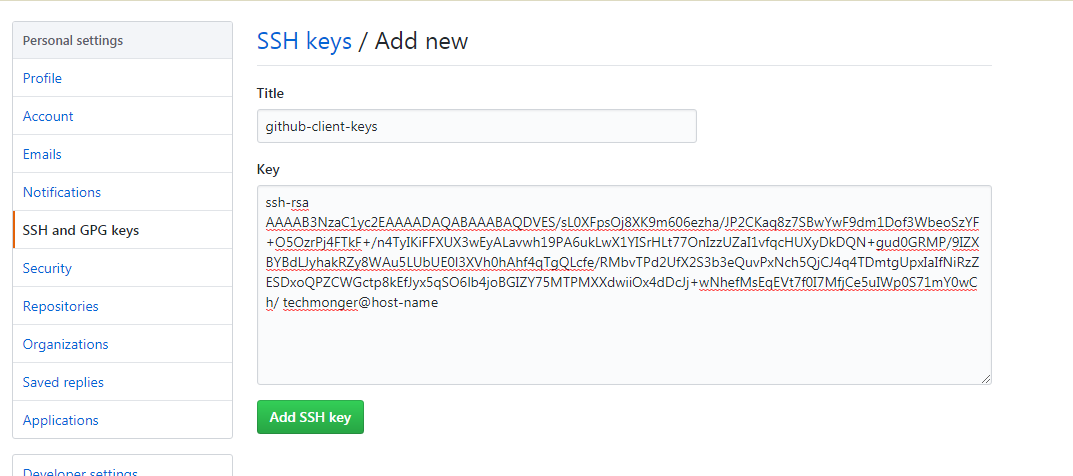Using Git with SSH in Windows 10
Geofront CLI client. It provides a CLI client for Geofront, a simple SSH key management server. It is available on PyPI, so you can install it using pip installer. We, however, recommend to use pipsi instead so that geofront-cli and its dependencies don't make your global site-packages messy.
Termius is more than a mere SSH client – it’s a complete command-line solution that’s redefining remote access for sysadmins and network engineers. Securely access Linux or IoT devices and quickly fix issues from the comfort of your couch via laptop or phone. Execute command and response result for an array Response,Error $ssh-cmd ($command) scpsend. Send file via SCP Protocol. $client-scpsend ($localfile,$remotefile,$createmode = 644) scprecv. Receive file via SCP Protocol. Remote Development using SSH. The Visual Studio Code Remote - SSH extension allows you to open a remote folder on any remote machine, virtual machine, or container with a running SSH server and take full advantage of VS Code's feature set. Once connected to a server, you can interact with files and folders anywhere on the remote filesystem. No source code needs to be on your local machine to. After checking the above-given steps, navigate to your GitHub account to the repository page which you want to clone. Press Clone or download and press Use SSH in the panel that appears. The panel will change to Clone with SSH with the updated link. Copy the link by pressing the Copy To Clipboard icon.
Although Git can be used over HTTPS with username and password authentication, it's much more convenient to use over SSH. Even with Git Credential Manager for Windows being bundled with Git for Windows.

Now that OpenSSH client is included in Windows 10, SSH can be easily set up without any third-party clients:
First, generate your SSH key. Although you can transfer key files between computers, I suggest generating a new one on each computer you use.
Then, associate the generated key with your Windows login by adding it to the OpenSSH Authentication Agent service.
In my case, the service was disabled and the command failed with the following error:
Error connecting to agent: No such file or directory
The documentation suggested trying to start the service:
For me, it just failed with a different error:
Start-Service : Service 'OpenSSH Authentication Agent (ssh-agent)' cannot be started due to the following error: Cannot start service ssh-agent on computer ' .'.
To resolve the issue, I had to change the service startup type from Disabled to Automatic in its properties dialog (and start the service then).
With that, the command-line Git client is ready to be used with SSH.
UI clients will typically require additional configuration which is application dependant. In my favorite UI client Fork, this can be done in the File > Configure SSH Keys dialog.
Of course, the contents of the generated SSH public key file (with .pub extension, e.g. id_rsa.pub) must be added to your account for the Git service provider. Add the same key to all services, if you use multiple.
The location of the relevant settings differs between the Git services:
- In GitHub, it's in the SSH and GPG keys section of Personal settings.
- In GitLab, it's in the SSH Keys section of User Settings.
- In Bitbucket, it's in the SSH keys section of your Bitbucket settings. URL is different for different users.
- In Azure DevOps, it's in the SSH public keys section of User settings. URL is different for different users.
Github Ssh Access

Make sure that you use the SSH URL instead of the HTTPS one when cloning new repositories (it's the one not starting with https).
For existing repositories, you can change the remote URL to the SSH one, e.g.:
Java Ssh Client Github
You can configure Git to use Bitvise SSH Client to connect to a repository over SSH. You can do this for:
- Convenience: You may already have Bitvise SSH Client set up, or you may prefer it for Kerberos authentication.
- Performance: You may find Bitvise SSH Client is faster in your environment.
The component of the SSH Client that can be used for this purpose is sexec. This is a command line client that supports a variety of command line parameters. To learn more about the possible parameters, run sexec in a Command Prompt or PowerShell window like this:
sexec -?
Or like this:
sexec -? | more
Since Git version 2.10, you can configure the Git configuration variable core.sshCommand. You can configure this to run sexec as follows:
git config --global core.sshCommand 'sexec -git -pk=g1'
Notes:

To use the -git parameter, use Bitvise SSH Client version 7.36 or later.
This will authenticate against any SSH server you use with Git using the key stored in the SSH Client's location Global 1.
To use different authentication credentials for different servers, omit the parameter --global so as to configure core.sshCommand specific to the current repository.
Android Ssh Client Github
If instead of -pk=..., you prefer to authenticate using a client key stored in a file, use:
Ssh To Github
git config --global core.sshCommand 'sexec -git -keypairFile=C:/Path/To/keypair.bkp'
Web Ssh Client Github
Note the use of forward slashes instead of backslashes because Git interprets backslashes as escape characters.

